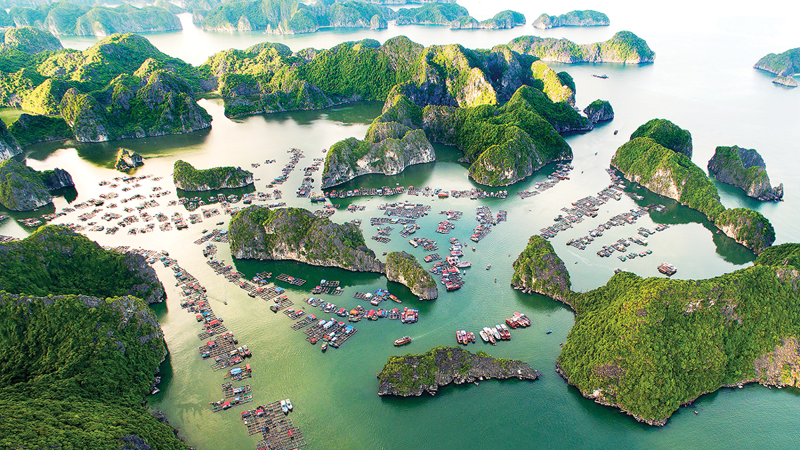Vietnam’s tourism story in 2024 featured a remarkable comeback. The country welcomed an estimated 17.5 million international visitors, up 38.9 per cent against 2023, alongside 110 million domestic travelers, for modest but steady growth of 1.6 per cent, according to the Ministry of Culture, Sports, and Tourism (MoCST). The allure of Vietnam’s cultural richness and natural beauty translated into impressive total revenue of some VND840 trillion ($33.6 billion), a 23.8 per cent leap over 2023. This resurgence not only highlights the vibrancy of the tourism sector but also cements its role as a beacon of hope in the country’s socio-economic tapestry.
Behind this revival lies a concerted effort led by MoCST in partnership with other ministries, sectors, and localities. Guided by Resolution No. 08-NQ/TW, dated January 16, 2017, from the Politburo on developing tourism into a key economic sector, the Law on Tourism 2017, and directives from the government, Vietnam is charting a path towards turning tourism into a spearhead economic sector.
Vietnam’s tourism recovery is not just about numbers; it’s a testament to resilience and reinvention. From bustling cities to serene beaches, the country has turned the post-pandemic challenge into an opportunity to redefine itself, offering travelers not just a destination but a story of safety, beauty, and warm hospitality.
Colorful picture
A bright new chapter unfolded in Vietnam’s tourism story in 2024. Major airports buzzed with life once more, while beloved destinations like Ha Long Bay, Hoi An ancient town, and the hill town of Sapa were alive with visitors rediscovering their charm. Iconic events such as the Hue Festival, Carnaval Ha Long, and beach escapes in Da Nang and Phu Quoc Island injected even more vibrancy into Vietnam’s travel landscape. As green tourism takes center stage, hotels and resorts are not just recovering but innovating, leveraging technology to reaffirm Vietnam’s standing on the global tourism map.
Minister of Culture, Sports, and Tourism Nguyen Van Hung proudly noted that 2024 saw the first successful Vietnam Tourism and Cinema Promotion Program in the US, with the theme “Vietnam - New Destination of World Cinema”. The program received widespread acclaim from both US and international filmmakers, leading to the signing of numerous cooperative agreements. Its impact is already clear, with many agreements signed and at least five international film crews set to capture Vietnam’s beauty on screen.
The year was also a stage for major tourism events that resonated with businesses and international travelers, underscoring Vietnam’s potential in rural tourism, cinematic tourism, and adventure travel. Creative campaigns across China, Europe, and Russia further expanded the country’s reach, boosting tourism growth with impressive results.
Vietnam played host to the UN Tourism’s first Global Conference on Tourism for Rural Development in Hoi An, while the National Tourism Year 2024, held in northwestern Dien Bien province, brought with it a cascade of promotional activities across key locations. This initiative fueled growth in all major indicators, from visitor numbers and revenue to accommodation, dining, and leisure services.
The domestic tourism campaign, “Vietnamese people traveling in Vietnam - Vietnam I love”, turned heads with its fresh take on travel promotion. Cities and provinces around the country launched innovative travel packages and services, delivering high-quality experiences and amplifying the joy of exploration. Tourism authorities doubled down on ensuring security, maintaining cleanliness, and creating a civilized, safe environment for every traveler.
Around the country, innovative tourism models are now emerging as symbols of a brighter future. These smart, sustainable initiatives reflect the green and dynamic spirit of Vietnam’s tourism revival. Visitors now fall in love with “Hanoi - Come to Love”, find happiness in “Da Nang - Where happiness begins”, and embrace the eco-conscious vibe of Ho Chi Minh City’s “Green on every journey”.
Vietnam’s tourism also continued to shine on the international stage, as it took home three coveted titles at the World Travel Awards: Asia’s Leading Destination, Asia’s Leading Heritage Destination, and Asia’s Leading Nature Destination.
Mr. Pham Hai Quynh, Director of the Asian Tourism Development Institute (ATI), observed that Vietnam’s tourism sector has largely bounced back to 2019 levels, with some source markets even experiencing a boost. In addition to its more relaxed visa policies, Vietnam has ramped up its promotional efforts, engaging travelers through music festivals, film events, and dynamic online campaigns. These efforts had a direct impact, inspiring international tourists to choose Vietnam as the site of their next adventure.
Of the 17.5 million international visitors last year, those from China and South Korea accounted for more than half, at around 8 million, while Europe and the US contributed approximately 5 million. This broad market appeal underscores Vietnam’s diverse tourism offerings, ensuring the country isn’t overly reliant on any one region.
A standout achievement has been Vietnam’s new e-visa policy, now available to citizens of all countries, allowing temporary stays of up to 90 days. This, along with the expansion of unilateral visa exemptions and an extended stay limit of 45 days, has made it significantly easier for international tourists to visit and explore Vietnam.
Deputy Minister of Culture, Sports, and Tourism Ho An Phong highlighted that tourism has become a vital pillar of the nation’s economy. In addition to the sector’s swift recovery from the Covid-19 pandemic, Vietnam has steadily earned prestigious international accolades. Tourism’s rapid growth has sparked positive momentum, benefiting many other industries across the country.
Breaking through the barriers
Mr. Ha Van Sieu, Deputy Director General of the Vietnam National Authority of Tourism (VNAT), highlighted that 2025 is set to be a transformative year for Vietnam’s tourism, a year of rapid expansion, overcoming obstacles and creating the solid foundation necessary to propel the country into a new era. Among its ambitious targets, the sector aims to attract 22-23 million international visitors and cater to 120-130 million domestic travelers, generate revenue from VND980 trillion to VND1,050 trillion ($39.2 billion to $42 billion), and create 5.5 million new jobs.
To turn these goals into reality, experts believe Vietnam must continue tackling key challenges head-on with bold, game-changing policies.
In regard to the visa policy, Mr. Quynh noted that while Vietnam has made strides forward, it hasn’t yet reached the breakthrough level that could truly propel its tourism sector into the next stage of development. Meanwhile, Thailand, a fierce competitor, has taken bold steps by repeatedly introducing visa exemptions - eliminating visa requirements altogether for key markets like China and India, expanding visa-free access, and consistently offering attractive incentives. These initiatives have paid off, with the country believed to have welcomed 2 million Indian tourists in 2024, or four-times the number Vietnam expected to arrive on its own shores. Thanks to new visa policies and partnerships with airlines to open new routes, Thailand is also positioning itself as a top destination for global travelers, leaving Vietnam with much to do to catch up.
Beyond visa policies, Mr. Nguyen Tien Dat, CEO of AZA Travel and Vice President of the Hanoi Tourism Association, pointed out that Vietnam’s tourism infrastructure still faces challenges. International airports like Noi Bai in Hanoi and Tan Son Nhat in Ho Chi Minh City are often overloaded, with long wait times for check-in. While direct flights to destinations like Da Nang and Nha Trang (in south-central Khanh Hoa province) have helped disperse tourists, major hubs continue to face congestion.
“Vietnam’s strengths - its cuisine, people, and natural beauty - are key to attracting international visitors,” he emphasized. “However, it is crucial to ease visa and aviation barriers. Once demand is there, businesses will invest in infrastructure, but visa access is key to bringing tourists in.”
He also noted the need for high-quality products to attract the luxury market. While Vietnam has options for Asian tourists, there is a lack of offerings for Western travelers, with little change made over the years apart from adventure tourism in central Quang Binh and northern Ha Giang provinces. To grow Vietnam’s tourism sustainably, Mr. Dat emphasized the importance of a national strategy, beginning with market analysis, followed by tailored tourism products and the targeted promotion of destinations.









 Google translate
Google translate